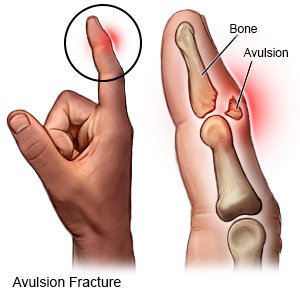Avulsion Fracture
Medically reviewed by Drugs.com. Last updated on Nov 3, 2024.
What is an avulsion fracture?
An avulsion fracture is when a small piece of bone breaks and pulls away from a larger bone. Part or all of the piece may break away.
 |
What are the signs and symptoms of an avulsion fracture?
- Pain, tenderness, and swelling
- Trouble moving the area near the avulsion fracture
- Trouble putting weight on the side of the avulsion fracture
How is an avulsion fracture diagnosed?
Your healthcare provider will ask about the activity you were doing before your injury. Your provider will also examine the area by touching it and moving it. An x-ray, CT, or MRI may show the avulsion fracture. You may be given contrast liquid to help the fracture show up better in the pictures. Tell the healthcare provider if you have ever had an allergic reaction to contrast liquid. Do not enter the MRI room with anything metal. Metal can cause serious injury. Tell the healthcare provider if you have any metal in or on your body.
How is an avulsion fracture treated?
Treatment depends on the location and type of fracture you have. You may need any of the following:
- Pain medicine may be given. Ask your healthcare provider how to take this medicine safely.
- Surgery may be needed if your fracture is severe or does not heal with other treatments. Surgery helps return the bones to their normal position using metal pins, screws, or plates.
How can I manage my symptoms?
- Get plenty of rest while your fracture heals. Limit activity as directed. When the pain decreases, begin normal, slow movements. Slowly start to do more each day.
- Apply ice to decrease swelling and pain. on your injury for 15 to 20 minutes every hour or as directed. Use an ice pack, or put crushed ice in a plastic bag. Cover the bag with a towel before you apply it to your skin.
- Elevate the area to decrease swelling and pain. Keep your injured limb above the level of your heart as often as you can. Prop the area on pillows or blankets to keep it elevated comfortably.
- Use support devices as directed. You may need to use crutches or a walker until your fracture heals. Ask for more information about how to use these walking devices if needed.
Call your local emergency number (911 in the US) if:
- You feel lightheaded, short of breath, and have chest pain.
- You cough up blood.
When should I seek immediate care?
- Your leg feels warm, tender, and painful. It may look swollen and red.
- Your cast cracks or is damaged.
- The pain in your injured limb gets worse even after you rest and take medicine.
- The skin, toes, or fingers of your injured limb become swollen, cold, or blue.
When should I call my doctor?
- You have numbness or tingling in your hand or foot below your cast.
- You cannot move your fingers or toes below the cast.
- You have new sores or redness around your cast or splint.
- You have new or worsening trouble moving your injured limb.
- You have questions or concerns about your condition or care.
Care Agreement
You have the right to help plan your care. Learn about your health condition and how it may be treated. Discuss treatment options with your healthcare providers to decide what care you want to receive. You always have the right to refuse treatment. The above information is an educational aid only. It is not intended as medical advice for individual conditions or treatments. Talk to your doctor, nurse or pharmacist before following any medical regimen to see if it is safe and effective for you.© Copyright Merative 2024 Information is for End User's use only and may not be sold, redistributed or otherwise used for commercial purposes.
Learn more about Avulsion Fracture
Care guides
Further information
Always consult your healthcare provider to ensure the information displayed on this page applies to your personal circumstances.
